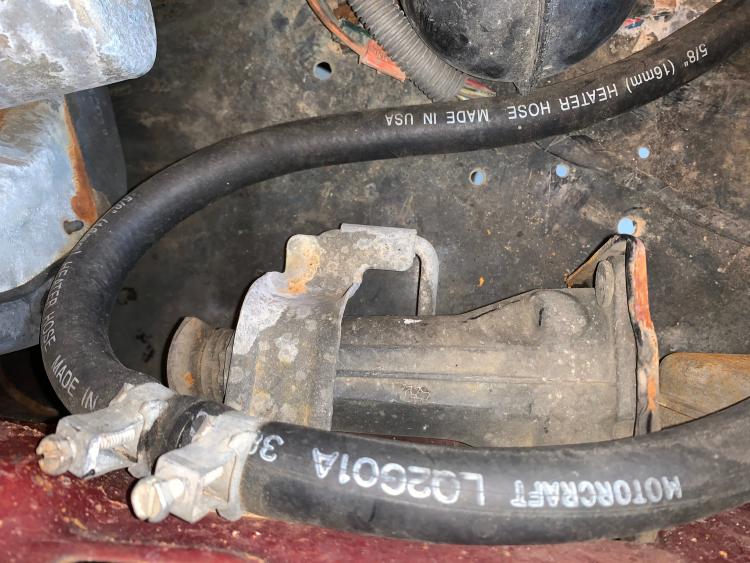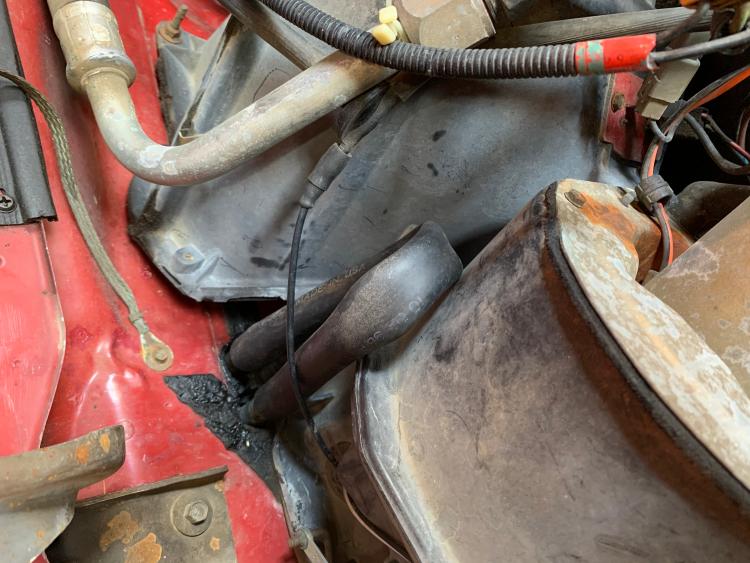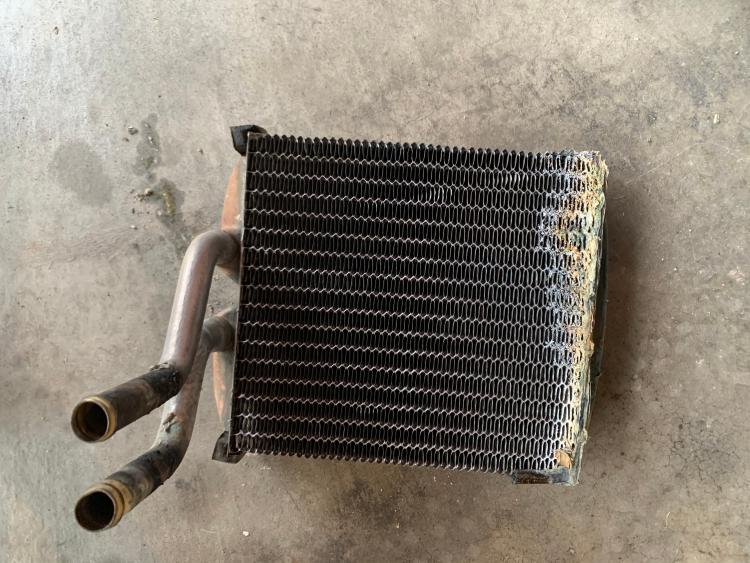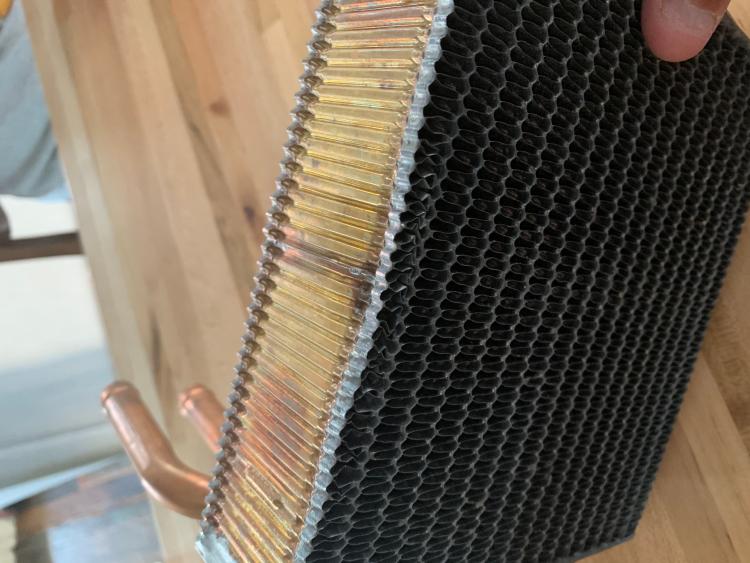Search Forum
Air Pump Delete for EFI upgrade
1234
















1234
Re: Air Pump Delete for EFI upgrade
|
Check out the big brain on Jim!
(It must run in the “Jim family”) Signed, Jim
1983 Bronco 4.9 300 I6
Current Name: Whitney |
Re: Air Pump Delete for EFI upgrade
|
Administrator
|
Hi! I'm the resident materials science and chemistry nerd!
 Though I never graduated high school, and I'm entirely autodidactic, i have a GED with High Honors! (?) I also had the highest ASVAB score ever seen in Connecticut at the time I took it. We Jim's are a highly advanced species! Let no one underestimate us!!!! 😈 💪💪💪 
Jim,
Lil'Red is a '87 F250 HD, 4.10's, 1356 4x4, Zf-5, 3G, PMGR, Saginaw PS, desmogged with a Holley 80508 and Performer intake. Too much other stuff to mention. |
|
In reply to this post by ArdWrknTrk
Right, even with the atomizing mist of the injectors you still need heat to properly turn the fuel into a vapor.
Not only the surface area of the mist allows for ease of vaporization you also have the intake manifold itself helping to vaporize the fuel. The intake manifold will have vacuum on it which we all know lowering the atmospheric pressure results in lowering the boiling point of liquids, thus in the intake manifold having lower pressure due to vacuum being applied on the intake manifold itself the liquid fuel wont need as much heat to start turning into a vapor.
"Old Blue" - '56 Fairlane Town Sedan - 292-4V, Ford-O-Matic transmission, 3.22:1
'63 Belair 2dr sdn - 283-4V, Powerglide transmission, 4.56:1 '78 Cougar XR7 - 351-2V, FMX transmission, 2.75:1 9inch "Bruno" - '82 F150 Flareside - 302-2V, C6 transmission, 2.75:1 9inch, 31x10.50-15 BFG KO2 |
Re: Air Pump Delete for EFI upgrade
|
Administrator
|
And, of course we have summer and winter fuel here in the US.
Summer fuel won't vaporize in winter, and winter fuel is likely to vapor lock in summer. This is why Ford designed a system to keep inlet temperatures constant (100F?) Because carburetors don't have nearly as much self control as modern EFI.
Jim,
Lil'Red is a '87 F250 HD, 4.10's, 1356 4x4, Zf-5, 3G, PMGR, Saginaw PS, desmogged with a Holley 80508 and Performer intake. Too much other stuff to mention. |
|
Yep, that is one thing that plagues us that have cars we dont drive much. Its why I need to get in the habit of draining the tank on my '56 when the fuel season switches cause I think that is some of my driveability problem is I cant burn the fuel in the car fast enough due to limited driving so I end up with fuel from 3 to 6 months old before the ethanol treatment starts to break down and I have to drain the fuel.
I never really liked the whole high temp that they try to maintain. I think on here I saw a listing of specs on the temp sensors for the air cleaner. I have to check but if I am remembering right I would go with a lower temp one since I dont need to have such high temperature levels. All I know is there was a lot of thought put into the system and at the very least I will have the vacuum hoses hooked up even if I dont have it functional. Ideally I would like to have it functional as I am going to retain the EVAP functionality on my setup. Only difference is the fuel bowl vent line will be capped off. Thus only the fuel tank will be attached to the canister but I still will need a temp vacuum switch as I believe the HVAC purge valve is ported through said switch to stop purging when engine is cold.
"Old Blue" - '56 Fairlane Town Sedan - 292-4V, Ford-O-Matic transmission, 3.22:1
'63 Belair 2dr sdn - 283-4V, Powerglide transmission, 4.56:1 '78 Cougar XR7 - 351-2V, FMX transmission, 2.75:1 9inch "Bruno" - '82 F150 Flareside - 302-2V, C6 transmission, 2.75:1 9inch, 31x10.50-15 BFG KO2 |
Re: Air Pump Delete for EFI upgrade
|
Administrator
|
IDK?
Seems Ford had a lot of very intelligent and highly paid engineers design a system that had to work for the vast majority of their customers. I imagine the 100*(?) system was there because A) it accounted for the actual inlet air temp many people in the United States might actually have to drive through. B) it assures the fuel gets vaporized (no matter seasonal fuel) before entering the cylinders. Puddling fuel in the manifold is no way to meet emissions or mileage standards. And it makes for a crappy running vehicle... ETA: I'll burn through at least a few tanks of gas a week. At 6X19 (two tanks)= 114 gallons a week. That fuel doesn't sit around getting water bottom, or seeing the seasons change. Get out and drive. Try it some time...
Jim,
Lil'Red is a '87 F250 HD, 4.10's, 1356 4x4, Zf-5, 3G, PMGR, Saginaw PS, desmogged with a Holley 80508 and Performer intake. Too much other stuff to mention. |
|
lol I wish I could. my truck is blocking some of my vehicles and I leave the battery disconnected so it doesnt go dead from sitting. I try not to run the truck too much as I got the balancer off since I am going to pull the engine. but because of this it makes my 56 hard to get out to drive. Like wise I been trying not to drive my 56 till I get a chance to drop the transmission pan to adjust the forward band and see if that cures my falling out of gear when coming to a stop. if it does then I will be driving the car more. I just dont want to burn up the transmission trying to drive it when it falls out of gear into neutral every time I come to a stop. I rather get the transmission rebuilt before major damage in that case.
But on the engineer design, thats right. Lots of money is spent on the design and there is no reason they would do that if it wasnt for the best. Only problem comes in when we start making changes or upgrades the benefits remains to be seen. Like switching to a TBI style EFI, could retaining systems such as the vacuum switch to advance the timing in a overheat condition be a benefit to the EFI or not. We know it is for a carb cause the idle speed is set and the advancing of the timing will raise the idle speed up. With EFI, the IAC will maintain the preset idle speed. But something I been thinking about is what if the IAC idles the motor up in a over heat condition but you keep this vacuum temperature switch to advance the timing would this actually be of a benefit to raise timing along with idle speed in a over heat condition. From what I understand, advancing the timing too much can actually cause detonation but heat generation is created by running very retarded where the flame front is heating up more of the cylinders from firing too early putting excessive heat into the cylinder walls. So on paper the vacuum switch wouldnt make a difference and it appears to be this switch was only done as a way to idle the engine up in a over heat condition as it was the only way they could do it. So for me I will be replacing that switch with the vacuum control valve for the EVAP system. This would be best for me as my temperature sender for my gauge and my EFI will both be in the intake and my Edelbrock Performer intake only has two coolant ports. There is a third port pad that is not drilled but is marked that looks like it will go into the coolant and this is where I plan on drilling for the small sniper temp sensor since its right up against one of the intake runners the smaller sensor would be a better fit I feel than the larger 5/8" heater hose fitting. My temperature vacuum switch which is what was used on the EVAP will be mounted in my NOS thermostat housing as it isnt critical for that to read the exact temperature during warm up, but it is with the sniper to ensure it is seeing the warm up happening slowly vs after the thermostat where it goes from ambient temp to 200* instantly when the thermostat opens up. I just have to look up the part number for the sensor as I will be replacing it with a NOS unit over trying to salvage the original unit by trying to get it out of the old rusted thermostat housing.
"Old Blue" - '56 Fairlane Town Sedan - 292-4V, Ford-O-Matic transmission, 3.22:1
'63 Belair 2dr sdn - 283-4V, Powerglide transmission, 4.56:1 '78 Cougar XR7 - 351-2V, FMX transmission, 2.75:1 9inch "Bruno" - '82 F150 Flareside - 302-2V, C6 transmission, 2.75:1 9inch, 31x10.50-15 BFG KO2 |
Re: Air Pump Delete for EFI upgrade
|
Administrator
|
I think you have advanced and retarded confused there Rusty.
Retarded is not "too early" Advanced has the piston pushing up against the expanding flame front, and since there is a flywheel and other cylinders pushing too, it keeps going. Detonation (knock) is the supersonic shock wave inside your cylinders. As we know, chemical reactions (like burning, oxidation) increase with both heat and pressure. The very principle of an ICE is to use heat, to create pressure in a closed vessel, to push the piston down (in most cases  ) let's just say out of the cylinder... ) let's just say out of the cylinder...
But when you have the heat and expansion happening too early on the up-stroke the power doesn't chase the piston down, but fights it coming up. Decreasing combustion volume creates more heat, which creates more pressure... it's a chain reaction of terminal mass, as there's not enough room for the expanding combustion by-products.
Jim,
Lil'Red is a '87 F250 HD, 4.10's, 1356 4x4, Zf-5, 3G, PMGR, Saginaw PS, desmogged with a Holley 80508 and Performer intake. Too much other stuff to mention. |
Re: Air Pump Delete for EFI upgrade
|
Ya’ll ready to get weird?
So I’m installing the 3g alternator today and with it out I’m getting a good look at the intake and exhaust manifolds. That new heater plate needs the heater hoses attached to it, but I’m looking at what’s there and realize there’s just one long heater hose. Then I notice that there’s an extra heater hose that’s just being used as some sort of recycler? I’ve seen this in the Mercedes when people want heat in the winter because some AC system isn’t working, and the. They do something like this in the summer. Is that what’s happening here?  
1983 Bronco 4.9 300 I6
Current Name: Whitney |
Re: Air Pump Delete for EFI upgrade
|
Administrator
|
They just coupled it together.
A sure sign your heater core has a hole in it....
Jim,
Lil'Red is a '87 F250 HD, 4.10's, 1356 4x4, Zf-5, 3G, PMGR, Saginaw PS, desmogged with a Holley 80508 and Performer intake. Too much other stuff to mention. |
Re: Air Pump Delete for EFI upgrade
|
Administrator
|
It's not too hard to replace.
You just have to remove the glove box to get at the case.
Jim,
Lil'Red is a '87 F250 HD, 4.10's, 1356 4x4, Zf-5, 3G, PMGR, Saginaw PS, desmogged with a Holley 80508 and Performer intake. Too much other stuff to mention. |
|
In reply to this post by ArdWrknTrk
I got it reversed, I did reading on this with a 66 vette I put a sniper on the guy swears up and down that its the EFI causing his overheating problem but the guy bought the car from another guy and the other guy is claiming it never over heated but he never drove it and he added a electric fan keeping the mechanical fan.
This is where I did reading and it was too far advanced generates excessive heat and retarded will result in now power but no real heat generation and we checked everything on that car. He didnt use late model vortec intake gaskets that was blocking the coolant port, thermostat was gutted and still did the same thing, radiator not blocked off, water pump was flowing and we even threw another one on there just incase, we even pulled the drain plugs to see if the block was creted which it wasnt. Also checked timing and it was with in spec of 12* initial. Car left on a flat bed yesterday cause the guy didnt want us to pull the engine out and run it on a test stand to isolate the engine from the car and see if it would still go from cold to 240*F idling in the matter of 10 minutes. Guy was still adament it was the EFI even though handheld is showing the A/F ratio was 13.5:1 which was slightly rich which would provide a cooling effect on the engine not a overheat effect. If it was super lean around 15:1 or 17:1 then yeah maybe that could have an effect on the overheating.
"Old Blue" - '56 Fairlane Town Sedan - 292-4V, Ford-O-Matic transmission, 3.22:1
'63 Belair 2dr sdn - 283-4V, Powerglide transmission, 4.56:1 '78 Cougar XR7 - 351-2V, FMX transmission, 2.75:1 9inch "Bruno" - '82 F150 Flareside - 302-2V, C6 transmission, 2.75:1 9inch, 31x10.50-15 BFG KO2 |
Re: Air Pump Delete for EFI upgrade
|
In reply to this post by ArdWrknTrk
Yep. Parts aren’t too expensive either. Thanks!
1983 Bronco 4.9 300 I6
Current Name: Whitney |
Re: Air Pump Delete for EFI upgrade
|
Administrator
|
If those are 1983 Motorcraft hoses you might want to buy 10' of 5/8 hose as well.
Jim,
Lil'Red is a '87 F250 HD, 4.10's, 1356 4x4, Zf-5, 3G, PMGR, Saginaw PS, desmogged with a Holley 80508 and Performer intake. Too much other stuff to mention. |
Re: Air Pump Delete for EFI upgrade
|
Administrator
|
Scratch the length.
I don't know how many feet a 300 needs.
Jim,
Lil'Red is a '87 F250 HD, 4.10's, 1356 4x4, Zf-5, 3G, PMGR, Saginaw PS, desmogged with a Holley 80508 and Performer intake. Too much other stuff to mention. |
Re: Air Pump Delete for EFI upgrade
|
Update on the work. Lots of frustration. I definitely had a leaky heater core. I found a motorcraft brass/copper one on ebay from JC Whitney but it arrived damaged. It was the last one they had in stock and it looks like it was nearly the last one anyone had easily available. Ford discontinued it so I’ll likely have to go with an aluminum aftermarket one unfortunately.
  On the EFI prep, I have the carb off and all the intake bolts loose. I’m really struggling to get off the pipe that goes from the EGR system to the exhaust manifold. I just don’t have 27mm wrenches and I’m reticent to purchase one. The real problem with that pipe is than I can’t get the intake off with it there. I guess I’ll have to cut it, but I don’t really have any cutting tools either. Now that’s a tool I’m probably willing to purchase... Which gets me to the exhaust. I’m just checking out what I’m going to need to do to get this new Y exhaust hooked up - specifically, where it’ll attach to my existing exhaust and muffler. I’ve never done exhaust work, but it looks like I’ll need to cut the new Y piece too to get it attached. It’s hard to tell though. Maybe it’ll bolt right on. Anyway. 5 hours later and not much progress. 
1983 Bronco 4.9 300 I6
Current Name: Whitney |
Re: Air Pump Delete for EFI upgrade
|
Administrator
|
27mm is VERY close to 1 1/16"
I have that size for lug nuts and expect my six point impact socket would whip that nut off easily, if I cut the tube out of the way. But I also have a good amount of tools, and own combination wrenches --> 36mm. Aluminum is a much better heat conductor than brass. Yeah, you can't repair it with solder and a propane torch, but beyond that it's better in every way. Sometimes you just need to take a break and do something else. Lord knows I've had my share of truck frustration the past couple of months...
Jim,
Lil'Red is a '87 F250 HD, 4.10's, 1356 4x4, Zf-5, 3G, PMGR, Saginaw PS, desmogged with a Holley 80508 and Performer intake. Too much other stuff to mention. |
Re: Air Pump Delete for EFI upgrade
|
Administrator
|
In reply to this post by FrazerJames
I forgot to ask, which Y-pipe did you go with?
While I imagine most brands will have the joint in the same place, I'm not too sure about the 300. I know when we did Josiahs truck the Walker pipe needed drilled out where the Y was welded together. Not difficult with a 1 7/8" hole saw and an extension, but it was severely restricted.
Jim,
Lil'Red is a '87 F250 HD, 4.10's, 1356 4x4, Zf-5, 3G, PMGR, Saginaw PS, desmogged with a Holley 80508 and Performer intake. Too much other stuff to mention. |
Re: Air Pump Delete for EFI upgrade
|
I found this one. I have no idea if it’ll fit correctly but it was on a list of parts for doing this on a 300.
https://www.carid.com/walker/aluminized-2-bolt-flange-y-pipe-with-spherical-flare-mpn-45166.html?singleid=1370929768?utm_source=email&utm_medium=order&utm_campaign=order_tracking_number
1983 Bronco 4.9 300 I6
Current Name: Whitney |
Re: Air Pump Delete for EFI upgrade
|
Administrator
|
Not a fan of crinkle bends because I know they disrupt flow and rust like crazy, but it does have an O2 bung so that's a step towards EFI!
Just look down the sprue and make sure the path is clear.
Jim,
Lil'Red is a '87 F250 HD, 4.10's, 1356 4x4, Zf-5, 3G, PMGR, Saginaw PS, desmogged with a Holley 80508 and Performer intake. Too much other stuff to mention. |
Bullnose Enthusiasts Forum
|
1 view|%1 views
| Edit this page |

